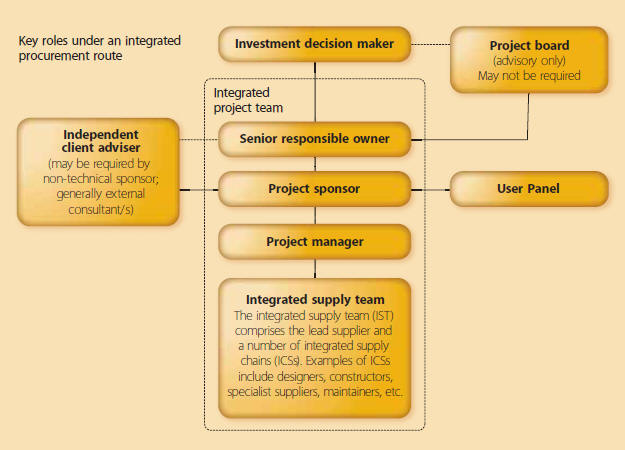Project sponsor for building design and construction
On publicly-funded projects, the project sponsor (sometimes known as the project director or client manager ref Achieving Excellence Guide 2 - Project Organisation) is,
...the interface between the client team and supply team via the project manager, as the main day-to-day client representative'
Ref OGC Project sponsor.
The project sponsor might be equivalent to a board director in the private sector.
For a very detailed description of tasks to be performed by the Project Sponsor see OGC guide Project organisation: roles and responsibilities (bullets listed below).
- support the SRO (senior responsible owner) by :
- preparing business case and investment appraisals and updating as required
- ensuring that Gateway reviews are undertaken
- managing the resources allocated by the SRO
- working within delegated authorities, including health and safety
- coordinating and directing user input
- appraising options (with assistance from independent client advisers, as appropriate, and the project manager) and submitting them to the SRO for approval
- preparing the project brief for the project manager, making the role of design clear in setting the brief and achieving the goals of the project
- controlling changes (if required) following approval, ensuring that change control procedures are adhered to
- ensuring appropriate risk management on the project
- managing the project budget, including the risk allowance
- secure professional services for delivery of the project by:
- appointing the integrated supply team (see AE5:The integrated project team) coordinating and fostering teamwork
- determining the procurement route (see AE6:Procurement and contract strategies)
- producing the project execution plan, including the risk management plan, in collaboration with the project manager
- ensuring the project is managed in accordance with the project execution plan
- establishing formal reporting arrangements on project progress
- providing a focal point for all client contact with the supply team, providing approvals and decisions as necessary
- carry out a post project review with the integrated project team
- ensure effective feedback from the project by assisting the SRO in carrying out a post implementation review to inform the IDM and SRO of:
- how far the project met the department's interests and objectives
- what lessons need to be learned for the future (things done well and areas that need to improve).
The relationship between the project sponsor and the rest of the project team is illustrated in OGC guidance as shown below:
Illustration reproduced with permission from OGC ref Project organisation: roles and responsibilities.
NB The Office of Government Commerce (OGC) has now been absorbed into the Efficiency and Reform Group (ERG) within the Cabinet Office. OGC guidance has been archived, however, it is cited in the Government Construction Strategy and the Common Minimum Standards, and links are provided to OGC documents from government websites such as the Major Projects Authority. The OGC gateway review process still provides one of the best and most comprehensive sets of guidance for public projects. It is for this reason that the project plan for public projects within Designing Buildings Wiki follows the OGC gateway review process.
Improving Infrastructure Delivery: Project Initiation Routemap, Handbook, Version 2 June 2016, published by the Infrastructure and Projects Authority, states: ‘The sponsor organisation secures the funding, owns the business case and is responsible for specifying the requirements to the client. The Sponsor ensures that the project remains strategically aligned and viable, and that benefits are on track to be realised. In some contexts the Sponsor and Client could be from the same organisation.’
[edit] Related articles on Designing Buildings Wiki
- Champions.
- Independent client adviser.
- Integrated project team.
- Integrated supply team.
- Investment decision maker.
- Owner.
- Project board.
- Project manager.
- Senior responsible owner.
- User panel.
[edit] External references
Featured articles and news
RTPI leader to become new CIOB Chief Executive Officer
Dr Victoria Hills MRTPI, FICE to take over after Caroline Gumble’s departure.
Social and affordable housing, a long term plan for delivery
The “Delivering a Decade of Renewal for Social and Affordable Housing” strategy sets out future path.
A change to adoptive architecture
Effects of global weather warming on architectural detailing, material choice and human interaction.
The proposed publicly owned and backed subsidiary of Homes England, to facilitate new homes.
How big is the problem and what can we do to mitigate the effects?
Overheating guidance and tools for building designers
A number of cool guides to help with the heat.
The UK's Modern Industrial Strategy: A 10 year plan
Previous consultation criticism, current key elements and general support with some persisting reservations.
Building Safety Regulator reforms
New roles, new staff and a new fast track service pave the way for a single construction regulator.
Architectural Technologist CPDs and Communications
CIAT CPD… and how you can do it!
Cooling centres and cool spaces
Managing extreme heat in cities by directing the public to places for heat stress relief and water sources.
Winter gardens: A brief history and warm variations
Extending the season with glass in different forms and terms.
Restoring Great Yarmouth's Winter Gardens
Transforming one of the least sustainable constructions imaginable.
Construction Skills Mission Board launch sector drive
Newly formed government and industry collaboration set strategy for recruiting an additional 100,000 construction workers a year.
New Architects Code comes into effect in September 2025
ARB Architects Code of Conduct and Practice available with ongoing consultation regarding guidance.
Welsh Skills Body (Medr) launches ambitious plan
The new skills body brings together funding and regulation of tertiary education and research for the devolved nation.
Paul Gandy FCIOB announced as next CIOB President
Former Tilbury Douglas CEO takes helm.
UK Infrastructure: A 10 Year Strategy. In brief with reactions
With the National Infrastructure and Service Transformation Authority (NISTA).
























Comments